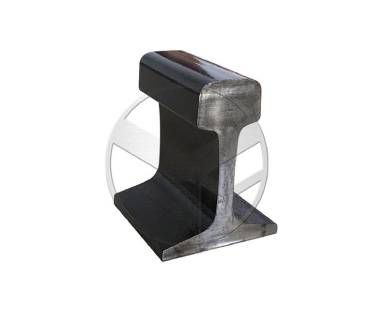Home >> News >> Latest News
It is generally believed that the shear stress under the rail surface caused by the contact stress is the main reason for the rail damage caused by the vertical force. Due to the interaction of wheels and rails, the contact stress on the top surface of the rails repeatedly causes plastic deformation, fatigue wear and fatigue cracks on the rail surface. The follow are some information shared by the Steel Rail Supplier about the damage to the surface of the rail:

Heavy Rails
Rail plastic deformation is directly proportional to contact stress and inversely proportional to rail hardness. When the contact stress is close to the shear yield limit of the rail, the contact surface begins to plastically deform. When the contact stress reaches 4 times the shear yield limit, continuous accumulated plastic deformation occurs on the contact surface, which causes the rail head to be widened or rolled. At the same time, the rail top surface metal is hardened, the hardness is increased, and fatigue cracks appear on the surface, which results in flake-like peeling. This is also the surface fatigue wear caused by contact stress.
When the contact shear stress caused by the contact stress is applied, the plastic flow deformation layer is deep, and the surface fatigue cracks develop obliquely and downwardly along the rheological direction. When the fatigue crack growth rate is greater than the wear, a small circle is formed on the inside of the rail top where the contact stress is greater Fish scale-like peeling cracks appear at the arc, and the depth of the peeling cracks corresponds to plastic deformation. Generally, it can reach more than 2mm at the outer radius of the small radius curve. Under the action of the sticky creep of the curved outer rail wheel rail, the crack development was promoted, and the fish scale cracks penetrated before and after the block appeared. Due to the unevenness of the track, the wheel / rail impact force was increased, and the crack development was accelerated. Inclusions will accelerate the initiation and development of cracks.
Nuclear damage originates from internal fatigue cracks within the range of 5-12mm below the rail head tread surface. Within this range is the area where the maximum contact shear stress is distributed. If oxide inclusions exist within this range, stripe fatigue will form. crack. After the transverse fatigue crack develops to a larger size, it may develop the transverse crack under the dynamic load of the wheel.
Wave grinding refers to the periodic wave-like deformation on the rail tread. There are many reasons for the formation of wave abrasion. It is generally believed that when the wheel runs on a curve, there is a "friction self-excited vibration" effect, which causes the wheel on one side to repeatedly adhere and slide. During the sliding process, the rail surface is plastically deformed and abraded, forming Wave troughs, crests appear during the adhesion process. The contact stress at the trough increases sharply, and the plastic fluidity deformation of the metal increases, which intensifies the development of wave wear.
The company also provides light rails and Heavy Rails, please feel free to contact us if necessary
Previous: Rail Development Direction

Leave a message